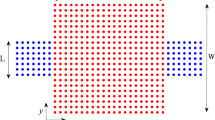Abstract
Measurements of the surface reactance, at a frequency of 100 MHz and at various temperatures, have been used to study some aspects of the proximity effect in lead films in contact with gadolinium. It has been found that although the normal metal in this case is magnetic an adequate explanation of the experimental results cannot be obtained by assuming that the Ginzburg-Landau order parameter vanishes at theNS interface. The microscopic theory that allows the boundary condition (∇Ψ) n =Ψ/b (wheren indicates the normal component of the gradient, Ψ is the order parameter, andb is called the extrapolation length) does agree well with both the dependence of the transition temperatureT cNS on the thickness of the superconducting layer and variation of the surface reactance with temperature.
Similar content being viewed by others
References
L. N. Cooper,Phys. Rev. Letters 6, 89 (1961).
V. L. Ginzburg and L. D. Landau,Zh. Eksperim. i Teor. Fiz. 20, 1064 (1950).
N. R. Werthamer,Phys. Rev. 132, 2440 (1969); P. G. deGennes,Rev. Mod. Phys. 36, 225 (1965).
G. Deutscher and P. G. deGennes, inSuperconductivity, R. D. Parks, ed. (Marcel Dekker, New York, 1969).
Orsay group, inQuantum Fluids, D. F. Brewer, ed. (North Holland, Amsterdam, 1966).
J. Bardeen, L. N. Cooper, and J. R. Schrieffer,Phys. Rev. 108, 1175 (1957).
P. Fulde and K. Maki,Phys. Kondensierten Materie 5, 380 (1966); K. Maki, inSuperconductivity, R. D. Parks, ed. (Marcel Dekker, New York, 1969).
J. J. Hauser, H. C. Theuerer, and N. R. Werthamer,Phys. Rev. 142, 118 (1966).
K. Maki,Phys. Rev. 141, 331 (1966).
D. E. Carlson and W. L. McLean,Phys. Rev. 176, 538 (1968).
R. O. Smith, thesis, Rutgers University, New Brunswick, N.J., 1969.
W. J. McG. Tegart,The Electrolytic and Chemical Polishing of Metals (Pergamon Press, London, 1956).
G. Hass,J. Opt. Soc. 39, 532 (1949).
W. L. McLean,Proc. Phys. Soc. (London)79, 572 (1962).
J. R. Waldram,Advan. Phys. 13, 1 (1964).
J. E. Aubrey,Phil. Mag. 5, 1001 (1960); R. F. Gasparovic, thesis, Rutgers University, New Brunswick, N.J., 1969.
J. J. Hauser,Phys. Rev. 164, 558 (1967).
R. G. Chambers,Proc. Roy. Soc. (London)A215, 391 (1951).
Author information
Authors and Affiliations
Additional information
Research supported by the National Science Foundation and the U.S. Army Electronics Laboratory, Fort Monmouth, New Jersey.
Part of this work was completed in the Department of Physics, University of California, Berkeley, during the tenure of a Rutgers University Research Council Faculty Fellowship.
Rights and permissions
About this article
Cite this article
Smith, R.O., McLean, W.L. & Serin, B. Proximity effect in gadolinium-backed lead films. J Low Temp Phys 4, 317–329 (1971). https://doi.org/10.1007/BF00629718
Received:
Issue Date:
DOI: https://doi.org/10.1007/BF00629718




